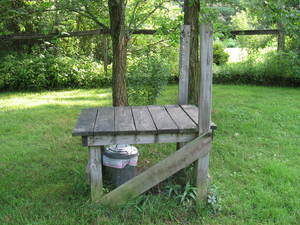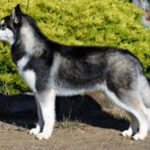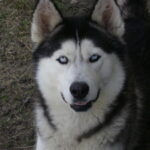I have owned Siberian Huskies for over 20 years and have bred them for 17. When I went to a show breeder to purchase a Siberian, my favorite breed of dog, I was asked a series of questions that the breeder used to see if I was a good candidate for ownership of this breed. I learned what was in store and I made the commitment to do what was needed to keep both the dog and myself healthy.
In the article “Owning a Siberian Husky things to Consider” I wrote a bit about all the things, both good and bad, that Huskies are notorious for. I mentioned the yearly molt. These dogs, like all of the northern breeds, have two layers of fur; a long top coat to help keep water from penetrating to the skin, and a thick soft ,short undercoat that is the insulation for the dog during the cold winter months. It is amazing how well the Siberian Husky thrives in the cold weather in snow that comes up to my knees. When it is windy and freezing, they simply burrow into the snow and are insulated against the winter temperatures. This undercoat gives the dogs a very fluffy appearance and makes the dogs soft and cuddly to hug. I do a lot of Husky hugging!
Then, however, comes the summer warm temperatures and the molting begins. As soon as the days and nights become warm and the day length increase the yearly molt begins. It starts as small puffs of fur sticking out of the dog’s sides. It can easily be pulled off and will fly though the air in the slightest breeze. But this is only the beginning. When the temperatures rises into the 80s and 90s the molt really takes hold. Then the fur starts flying with every pet and brush against the fur. This is the time to start the comb out of that fur.
I have read on many sites that Huskies molt twice a year. Of all the Huskies in my life, past and present, I only experience this molt once a year-and thank goodness for that. My dogs are in an outside kennel because I live in a five room ranch and it is just too crowded for the 7 of us. So they stay out in the kennel where they have insulated dog houses on a concrete bed and an acre of fenced-in running, digging, and playing room. It is often called Husky Heaven by many of our Husky-loving friends. who come over to allow their Husky to play. That is not to say that one or two dogs cannot be house dogs. The breed will make great indoor pets as well. However, during the molt, it is often very handy to have an outside area for grooming where the fur won’t cover every surface in your home for weeks.
I use a grooming table that is located outside in the kennel area when I groom the dogs because Siberian Huskies are a medium-sized dog that stand about three feet high at the back. This hight is very uncomfortable for grooming when the dog is standing on the ground and the groomer is standing-or rather bending-next to it. The back goes long before the fur. There are, of course, ready-made professional tables that are very expensive. I took the measurements from a few I saw advertised and using scrap pieces of wood, I constructed my own. It is made with pressure treated legs and has larch-a very hard wood-for the top. I used a longer 2x4x8 pressure treated that was attached to the front legs and extends above the table where I attached eye hooks from which I can secure the dogs while I groom. This helps to keep them in place, sort of, and prevents them from chasing the dog who is awaiting its turn and is taunting the one on the table. As the picture shows, it is a bit rustic but very functional and I also use it when I give the dogs a good scrubbing. It is the perfect height for hugs as well!
I usually wait until I see the fur come out in large lumps at the sides before I begin the grooming. Each of my dogs seem to have its particular time when the fur really loosens up, and this is good because I can spend all the time needed to groom out all the fur of each dog before I begin another.
As soon as I see the fur loosen all over the body, I comb the fur with a special comb made especially for gently pulling out the undercoat. They are very inexpensive, usually under $15,00 and work wonders. Before I used the undercoat comb, I used a brush but it never seemed to get all the fur no matter how long I groomed.
It is important to know that the dog will not molt its first summer. If you purchased a pup in spring, it will not molt the first summer, although it may shed a bit. If you have purchased a fall pup, it will molt the following summer, but it may not be as total as the next summer.
Here are the steps I recommend for grooming your Husky each summer.
1. As soon as you get your puppy, start using a brush and comb on it so it will be used to the touch and will not be frightened when the time comes to groom. This is a good time to begin to train it to stand while you handle its back, legs, tummy and especially its tail. Most dogs love to have their head and back groomed, but not all will tolerate the tail bing fooled around with. If you begin young it will stand well for you so you can get the tail and it will love all the attention.
2. Wait until the fur is really coming out. Too early and you will not get much. Grooming is tiring and the easier the fur the comes out, the easier the grooming.
3. Use an undercoat comb. One with a handle works best for me and helps me to get at those hard to reach areas that need grooming as well.
4. Make sure you groom all the fur over the dog’s entire body. The back and side are the easiest, but all that undercoat needs to come out each year. If it is not combed out, it may not come out on its own and the fur will be be rough. The fur on the stomach, hips, head, chest, legs, the pants (the thick bundle of fur on the upper part of the back legs), as well as the tail should be removed so new , soft fur will grow back in its place. If all the undercoat is not combed out, no new undercoat will grow in the places not groomed, and your dog’s fur will not be healthy looking the next winter. It takes more time but it is healthier for the dog. It ususally takes about two weeks of grooming for about 1/2 to one hour a day to get out all the fur.
5. Once all the undercoat is combed out (you will know this because no more fur comes out when you comb and the dog looks like you’ve put in on a starvation diet) it is time to concentrate on the longer thicker fur of the outer coat. If the dog is groomed properly, the long outer fur will come out as well, but it usually does not flow out as easily with the comb. Here the brush often helps, but pulling those course strands out with your fingers works best. It must be very comical to see me pulling out the long top fur because I work it out with fast rapid pulls. The dogs act like I’m nuts and usually won’t stand as long for this type of grooming. It usually takes another week or so to get it all out as well.
6. Once all the grooming is done, it is time for the yearly bath. I never recommend bathing a Husky more than once a year after it reaches a year old. The dog produces an oil from its skin to help protect it from water, and bathing removes this protective oil. Besides, if you have ever tried to give an adult Husky in full coat a bath, you will know it takes forever to penetrate the fur down to the skin. Waiting until the coat is molted makes bathing much easier and faster. This is the time to rid the dog of all old, flaking skin. Using a gentle cleansing shampoo and even a cream rinse will really make your dog more hug-able! It will shine and smell great, at least for an hour or two before it rolls in the mud again!
It usually takes about three to four weeks for the new coat to fully grow in. When one of my females whelps a litter she will always molt once the pups are weened even if it has just grown in a new coat. If this happens in the winter, it is very important to make sure the dog has the protection of another dog in full coat, or the warmth of a home when the temperatures are the coldest. I will never give her a bath after this molting unless it is in the summer months where she will be warm after bathing.
After my dogs have their bath, usually given outside where the splashing doesn’t matter, and the soaking I get is welcome on a hot summer day, I will let them inside when the days are really hot and we have the air conditioning on. They will chase the cats for bit until they learn who’s the boss inside, and then settle down to a nice nap in the cool air. But they love the outdoors and only tolerate being inside for a short time. They have more room for getting into trouble outside!
Because I only have an acre for the kennel, we do not have many dogs at one time. I dog sled and because my sled weighs only eight pounds, I only need a few dogs to pull me through the snowy countryside. When they are in full, shiny coat, they are a beautifyl sight to see. The dogs simply shake off the snow and the cold winter days and nights are full of fun for both the dogs and myself.





